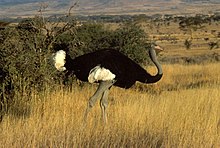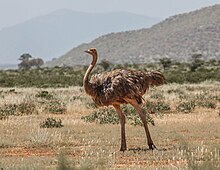Somali ostrich
| Somali ostrich | |
|---|---|
 |
|
| Male | |
 |
|
| Female | |
| Scientific classification | |
| Kingdom: | Animalia |
| Phylum: | Chordata |
| Class: | Aves |
| Superorder: | Paleognathae |
| Order: | Struthioniformes |
| Family: | Struthionidae |
| Genus: | Struthio |
| Species: | S. molybdophanes |
| Binomial name | |
|
Struthio molybdophanes Reichenow, 1883 |
|
| Synonyms | |
Struthio camelus molybdophanes
(Reichenow, 1883)
The Somali ostrich (Struthio molybdophanes) is a large flightless bird native to the Horn of Africa. It was previously considered a subspecies of the common ostrich, but was identified as a distinct species in 2014.
Molecular evidence indicates that the East African Rift has served as a geographic barrier to isolate the taxon from the nominate subspecies, the North African ostrich S. c. camelus, while ecological and behavioural differences have kept it genetically distinct from the neighbouring Masai ostrich S. c. massaicus. An examination of the of Struthio taxa, including the extinct Arabian ostrich S. c. syriacus, has found that the Somali ostrich is phylogenetically the most distinct, appearing to have diverged from their common ancestor some 3.6 to 4.1 million years ago.
Though generally similar to other ostriches, the skin of the neck and thighs of the Somali ostrich is grey-blue (rather than pinkish), becoming bright blue on the male during the mating season. The neck lacks a typical broad white ring, and the tail feathers are white. The females are slightly larger than the males and browner in plumage than other female ostriches.
The Somali ostrich is mostly found in Horn of Africa, especially in north-eastern Ethiopia and across all of Somalia. Its range corresponding roughly to the area known as the Horn of Africa.
The Somali ostrich is differentiated ecologically from the Common ostrich, with which there is some range overlap, by preferring bushier, more thickly vegetated areas, where it feeds largely by browsing, whereas the latter is mainly a grazer on open savanna. There are also reports of interbreeding difficulties between the two taxa.
...
Wikipedia

